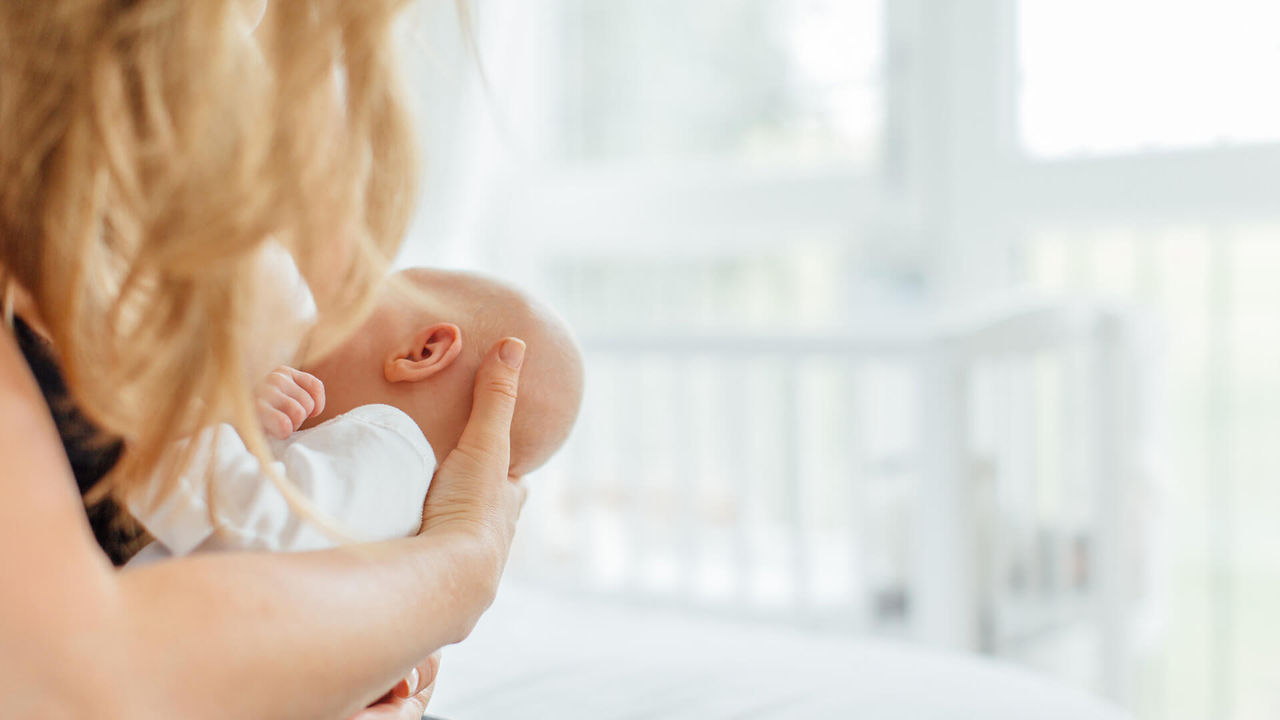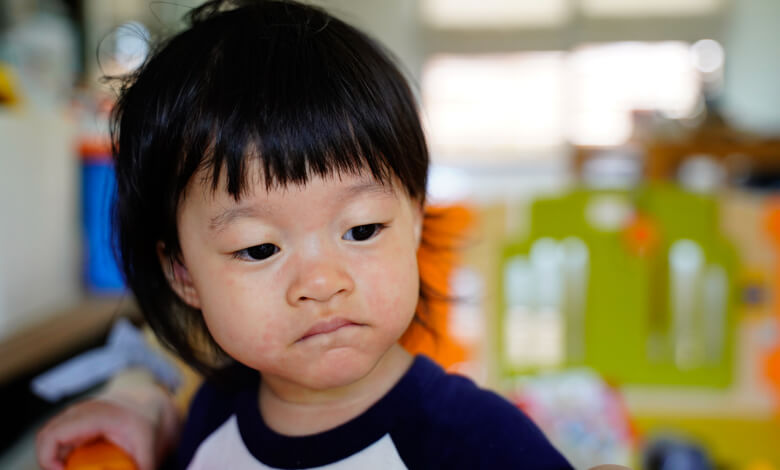- When a baby’s teeth start to break the surface of the baby’s gums it is called teething
- Baby teething can cause pain and discomfort for your baby
- Signs teething may be close are swollen gums and excessive dribbling
- Keep a clean washcloth in the fridge for your baby to chew on when gums are swollen
Common teething signs in babies: what to expect and how to help

Key points
While many babies experience teething with no issues, it’s not uncommon for some babies to experience discomfort or pain. Anytime your baby is distressed, your stress levels rise so let’s get to the suggestions as quickly as possible.
When do babies start teething?
A baby is born with teeth sitting under their gums. There are 20 in total, 10 in the upper jaw and 10 in the lower jaw. These are known as baby teeth, first teeth, primary teeth or milk teeth and will appear through the gums over time. Babies start teething at different times but most will have a full set of baby teeth by the age of 3.
When do they get baby teeth?
There is no set age for teeth to first break through your baby’s gums. For some babies, the first sign of a tooth will happen at around 3 months, whereas for others it may not be until around 12 months. What is consistent is the order in which teeth emerge. This teeth development map will give you an idea of where you can expect new teeth to appear and when.
Teeth Development Map
Lower teeth usually emerge first
● 6 to 10 months – Central incisors
● 10 to 16 months – Lateral incisors
● 17 to 23 months – Canines
● 14 to 18 months – First molars
● 23 to 31 months – Second molars
Upper Teeth
● 8 to 12 months - Central incisors
● 9 to 13 months – Lateral incisors
● 16 to 22 months – Canines
● 13 to 19 months – First molars
● 25 to 33 months – Second molarsbe mind
Teething signs to look out for
It’s easy to miss the arrival of the first few teeth as you may mistake your baby’s teething pain for general discomfort. To be able to differentiate effectively, there are several teething signs to look out for, including:
● Crying more at night
● Demanding more attention than usual
● Flushed cheeks
● Excessive drooling
● Red and swollen gums
● Refusing feeds
● Chewing on hands or toys more than usual
● Rubbing or pulling on ears
● Disrupted sleep patterns
How to soothe a teething baby
Pain or discomfort associated with teething can disrupt your baby’s sleep routine which can have an impact on the entire family.
Luckily, you can use a few simple tips to help relieve discomfort and ease your little one’s pain, including:
Massage baby's gums
Using a clean finger or a soft, damp washcloth gently massage your baby’s gums. The pressure provides some short-term relief.
Apply a chilled washcloth
A soft fridge-chilled washcloth is a safe and inexpensive way to offer them some cool relief for swollen or inflamed gums. Just make sure the cloth is kept clean and rechilled when necessary.
Chilled teethers
Offering your baby a chilled teething ring to chew on can help relieve gum pain. Be careful not to freeze the teething ring solid to protect your baby's gums. Slushy consistency is great!
Silicone chew toys
Solid yet squishy, they can help relieve pain associated with teething with reverse pressure on the gums i.e. your baby's teeth are coming up, and the teether provides downward pressure when they bite. Be mindful to ensure they meet Australian/New Zealand safety standards (see below for more information).
Wooden teethers
Many parents still use ‘old school’ wooden pegs. They are an easy shape to hold, are firm and smooth. Be mindful they don't have any sharp or angled edges that can damage your baby's gums. Also check that only food grade oils are used to coat the wood rather than varnish or paint.
Ensure that any teether or chew toy you give to your baby has been independently verified and meets Australian and New Zealand safety standards. If unsure, before buying, ask the manufacturer if they have the AS/NZ ISO 8124:1:2016 certification. Do not sterilise plastic teething rings in boiling water or the dishwasher, unless specified by the manufacturer. Avoid products that contain a plastic softener called 'diisononyl phthalate' and look for certifications like Standard-100 by OEKO-TEX® which ensure a huge number of chemicals are at safe or non-existent levels in your baby's products. Avoid the ones that use a plastic softener called 'diisononyl phthalate'.
Teething rusks or biscuits
If your baby is around six months old and has started eating solid foods, you can give them a sugar free rusk or sugar-free teething biscuits. A baby rusk is a hard baked bread or biscuit used as a teething food for babies. They're designed so babies can chew and bite down on them without breaking the rusk. You can chill these in the fridge before giving them to your baby to help cool and relieve pressure on their gums.
Avoid giving rusks to your baby if they have not started solids, as rusks are considered a solid food and your baby’s immature digestive system may not be ready for them yet.
Dry the dribble
Although dribbling is normal for all babies, teething can increase saliva production even more. Some babies get a very sore and red area on their chin, neck and chest from excessive dribbling. To prevent and relieve soreness apply a barrier cream to the affected skin or gently wipe away the dribble from the area as often as you can.
Extra feeds
Sucking is a calming reflex for your baby, so offering them extra feeds gives them physical comfort. It also helps them swallow extra saliva and is very soothing.
Hugs and cuddles
Give your baby lots of hugs and cuddles. Play with toys or listen to music together anything to distract them from their teething symptoms. If giving a toy, most babies are likely to put it in their mouth, so make sure it is clean, and safe to use at their age.
Pain-relieving medication
If you can’t relieve your child’s pain by comforting them, helping them to relax, distracting them or providing a cool compress, pain-relieving medicines may help.
In Australia, over-the-counter Paracetamol can be used for mild to moderate pain in babies over one month old and is administered with a dropper.
In New Zealand, over-the-counter Pamol paracetamol can be given to babies over 3 months and all dosing under 12 months is based on the baby's weight. So you will need a script from your GP with a weight and dosage breakdown if your baby is under 3 months.
Always follow the written instructions or label on the pack carefully as the dosage is very small at this young age. Read the label or ask your pharmacist to advise you on the correct dosage for your baby.
Teething remedies to avoid
While you may want to try any type of relief to soothe your baby’s discomfort, there are a few teething remedies and products that are not safe and should be avoided. Before buying or using a teething relief product, always check that it is certified as safe for your baby.
Remember: never put anything in your baby's mouth that isn't specifically approved and proven to help ease your baby's teething symptoms.
Teething gels
The Therapeutic Guidelines in Australia (TGA) do not recommend teething gels because of the lack of evidence of results and the potential for harm.
Some teething gels contain ingredients that may be harmful to your child’s health. Lidocaine, a mild anaesthetic and benzocaine a numbing agent can be found in some teething products. Neither are recommended for children. If your baby accidentally swallows the gel applied to their gums, it can be difficult to determine the amount they consumed. This may also cause numbness in the throat and pose a choking hazard.
Choline salicylate is an ingredient in a number of products for teething and the relief of pain. From 1 October 2023, products containing choline salicylate for use in the mouth are now only available in pharmacies. The risks associated with prolonged use and overuse, especially in children, requires advice from a pharmacist to ensure safe use.
Teething necklaces
Teething necklaces such as amber teething necklaces are best avoided, as they are a strangulation risk and choking hazard. Before buying or using a teething relief product, check that it is certified as safe for your baby.
Homeopathic options
It is best to avoid any homeopathic teething options or check with your pharmacist or nutritionist first to make sure they are safe for your baby.
How to soothe a teething baby at night
It's important to try and keep the same bedtime routine. If they are over 4 months of age it may be time to introducte a sleep schedule if you have not done so already. This may help them to settle at night. If your baby wakes with sore gums, offer them an extra feed. Be patient and give them a cuddle to get them back to sleep.
Caring for your baby’s teeth
Once your baby is around 3 months old, you may want to start a good oral hygiene routine. Rubbing their gums daily, with clean gauze or a cloth is the first step. Once your baby's first tooth appears, purchase a soft toothbrush and gently brush the precious new tooth with water twice daily.
If your baby is bottle fed you need only to use water on the toothbrush until your baby is 2 years old unless your dentist suggests otherwise. Don’t put your baby to bed with a bottle and avoid feeding them sugary foods and drinks. It's important to feed them a healthy varied diet when they start solids to help avoid tooth decay.
When to visit the dentist
It is a good idea to regularly visit a dentist or oral health therapist for dental care. The best time is around their first birthday or when their first tooth comes through - whichever happens first. If your baby seems to be really struggling with teething pain, it’s best to consult with your healthcare professional to rule out any contributing factors.
- Better Health Channel. Teeth development in Children [Internet]. [Cited 23 Dec 15]. Available from: www.betterhealth.vic.gov.au/health/conditionsandtreatments/teeth-development-in-children
- Queensland Government. Health and wellbeing. Teething [Internet]. [Cited 23 Dec 15]. Available from: www.qld.gov.au/health/condition/mouth-and-dental-health/babies-and-toddlers/teething
- Healthy WA. Teething and your baby [Internet]. [Cited 23 Dec 15]. Available from: www.healthywa.wa.gov.au/Articles/S_T/Teething-and-your-baby
- Raising Children Network. Dental care for baby teeth and gums [Internet]. [Cited 23 Dec 15]. Available from: raisingchildren.net.au/babies/health-daily-care/dental-care/dental-care-babies
- Medsafe NZ. Reclassification of Choline [Internet]. [Cited 23 Dec 15]. Available from: https://www.medsafe.govt.nz/profs/class/ReclassificationOfCholineSalicylate.asp
- The Royal Children’s Hospital Melbourne. Pain relief for children – paracetamol and ibuprofen [Internet]. [Cited Dec 15]. Available from: https://www.rch.org.au/kidsinfo/fact_sheets/Pain_relief_for_children_-_Paracetamol_and_Ibuprofen/
- Therapeutic Goods Administration (TGA). Changes to choline salicylate access to start from 1 October 2023 [Internet]. [Cited 2023 Dec 15]. Available from: https://www.tga.gov.au/news/news/changes-choline-salicylate-access-start-1-october-2023
Related pages

Get in touch with our Careline experts
When your little one is unhappy or unwell you want reliable support from a trusted source. Our Careline team of nutritionists, dietitians and midwives specialise in infant and child health, offering free nutrition, feeding and product information.
Every feeding journey is unique
Not every parent can produce breast milk. No matter what choice you make, we will support your unique feeding journey.
We at Nutricia believe in providing the best nutrition for babies, which is why we recognise breast milk is uniquely superior for babies as it provides many benefits. It is important that mums have a healthy diet to support breastfeeding. A decision not to breastfeed, or partial bottle feed, may reduce breast milk supply making it difficult to reverse. The cost and social implications of using feeding methods should be considered. Always seek professional advice about feeding your baby. Ensure formula is used as directed as improper use can affect baby’s health.
REMEMBER: The information on this page is general only. If you have any concerns about your baby’s poo or questions about constipation or any other health concerns, please speak to a healthcare professional, like a Pharmacist, GP or Maternal Child Health Nurse.



